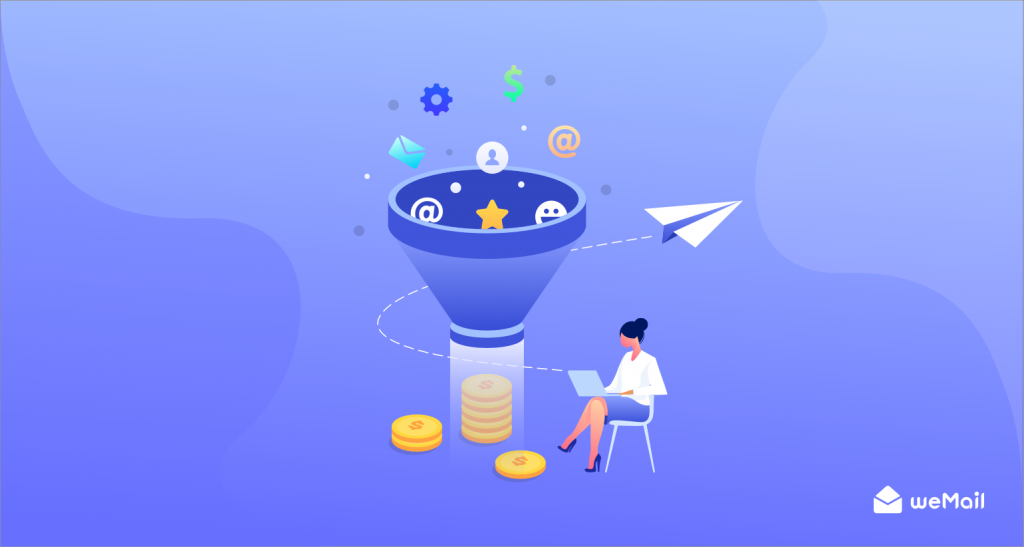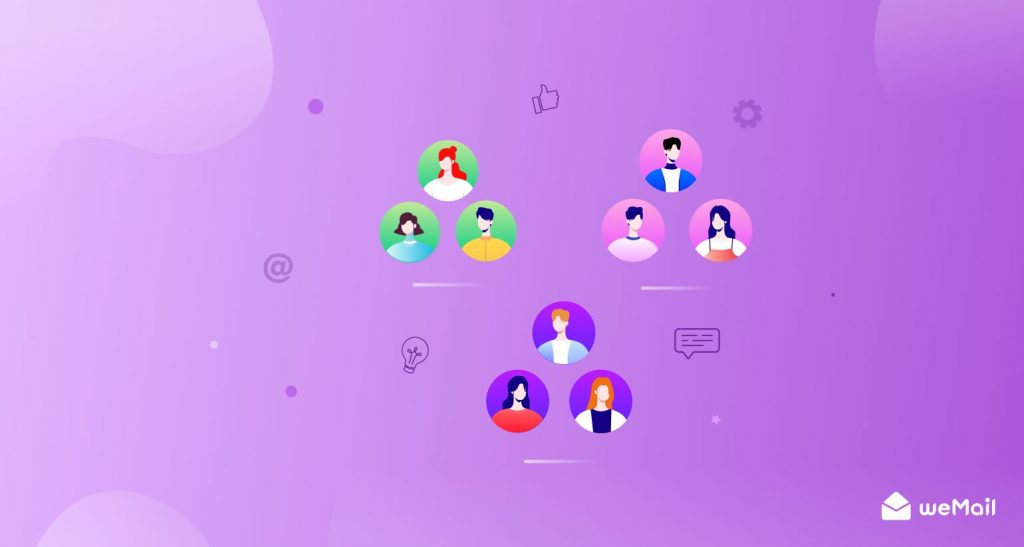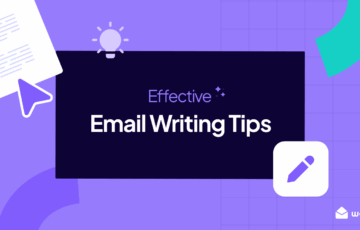What Is a Sales Funnel – Why It’s Important & How to Create One

Your customers undergo a journey before they end up purchasing a product or service. A sales funnel, as the marketing world labels this journey, carries valuable information about how at first visitors interact with your business until they are ready to buy what you offer.
In a sales funnel, you understand what overall results in your marketing and sales efforts produce as the potential customer moves through this funnel.
It is imperative for businesses to fully understand what a sales funnel is, the benefits of sales funnels, and how to create one.
This article explains everything you need to know about sales funnels, the different stages, and how to create one.
What Is a Sales Funnel

A sales funnel resembles a real-life funnel where every stage visually depicts how potential customers respond to marketing and sales strategy.
Starting from the broader part at the top, a number of website visitors begin their journey, and as the journey continues, the funnel gets narrower. Only a fraction of them ends up converting into customers.
Sales funnels often use AIDA (Awareness, Interest, Desire, and Action). We’ll discuss AIDA in more detail shortly.
The Awareness stage is at the widest part of the funnel because you want a broad reach to create as much awareness as possible.
As you filter prospects into those interested in what you offer and have the desire to buy, the funnel becomes narrower as the field becomes smaller.
Finally, you reach the customers who are genuinely ready to take Action.
Designing a sales funnel requires a lot of good data and a thorough knowledge of your target market. There is no one-funnel-fits-all model; it needs to be customized based on different business types and needs.
For example, for a typical eCommerce website, its sales funnel may begin with lots of visitors opening its homepage, going through different products, adding them to their cart, and eventually purchasing those items at the end of the funnel.
The Importance of Sales Funnels
Who wants to see prospects going away before taking action?
Losing potential customers in the middle of a sales funnel before they are ready to purchase your product is a massive challenge for business owners.
Lots of webinars, lead magnets, extensive content strategy, and social media campaigns put lots of extra pressure when you eventually miss out on sales.
It can be exhausting, frustrating, and demoralizing at the same time.
It’s crucial to understand every stage of a sales funnel. A well-thought-out sales funnel can help convert leads into customers and retain them.
Business owners and marketers need to understand all the stages of the customer journey. They must master the art of building a perfect sales funnel for that journey.
The better you understand this journey, the more leads you can convert into customers.
Fortunately, with the help of great tools specifically designed to optimize the visitor experience, you can save resources, better comprehend the customer journey and become more productive
Different Stages of a Sales Funnel
A sales funnel comprises four major parts summed up by the AIDA acronym – Awareness, Interest, Desire, and Action. These four parts describe the typical journey a customer makes when first exposed to your business or product.
Awareness
The broadest part at the top of the funnel, Awareness, is where your marketing strategy attracts the largest number of potential customers.
Think of a targeted blog post, a social media campaign, a marketing email, or a banner for guiding visitors to your landing page.
There are numerous other possibilities for your visitors to reach you. Someone can get information about your product from a friend or access your landing page after Googling a specific question or problem.
So designing a highly interactive and responsive landing page should be one of the first things on your “to-do” list.
But what is a landing page?
A landing page is where you try to grab your prospect’s attention. The art is to give it a clean look while highlighting everything that matters. It should be professionally designed and convincing and give your lead a reason to stay there.
Interest
Once on the landing page, visitors enter the second phase, Interest. Here they explore the page and read about the benefits of your product to hopefully generate interest in what the product or service is, or does.
The idea is not to oversell at this stage. If you act too pushy and become aggressive with your sales pitch, you might turn them off and give them a reason to leave.
Nurture your prospects and let them make an informed decision based on the knowledge you give them. The information on your page should look like a solution they seek.
Desire
Next is the third stage, Desire.
Your intelligent communication and marketing expertise have pushed the prospect further down the funnel. The visitor agrees with what you offer and researches it further, digging deeper into what it does, how it works, how much it costs, and so on.
Prospects want to make a decision now. The time is right; offer them something they can’t resist.
For example, you can give them a lucrative discount coupon, a free trial, offer a bundle package, or maybe free shipping.
Action
The final stage, Action, is the most critical part. It’s where your visitors turn into customers by purchasing the product. It is the most nerve-wracking stage of the sales funnel. If the prospect becomes a customer, all is good.
However, if you gain your customer’s trust in the early stage, the job doesn’t end there.
Customer Retention is of paramount importance. Although not a part of the original AIDA acronym, it is equally important.
Your primary goal is to make them your loyal customer. Show your gratitude with a “Thank You” email, and ask them to sign up for a newsletter if you offer one.
- Your blog posts should offer knowledge about the best use of your products and services
- Educate customers on the industry, so they learn more
- Send periodic updates about your latest products and offerings
- Provide the best customer support
Though a sales funnel isn’t limited to online businesses, let’s use a fully online business example.
Example of a Real Life Sales Funnel
Netflix runs a solid service that needs no introduction. It also utilizes the power of the sales funnel to encourage new users to sign up.
The funnel begins with generating awareness by outlining what Netflix offers (Awareness).
The homepage, which is also the landing page, lures the first-timer and existing subscribers with tons of offerings.
It then continues by outlining the features and benefits of memberships like TV on any device, download options, and children’s options (Interest).
It creates a desire by guiding you to key questions you’re likely to be asking yourself in the FAQ section (Desire).
Finally, it creates the action with a simple email signup call to action that requires almost zero effort (Action).
Even though you may not have realized it, you have probably been through hundreds of sales funnels in your time!
How To Create a Sales Funnel – a Step-by-Step Process

Creating a sales funnel is a relatively straightforward process if you use the right tool.
We recommend CartFlows to help create sales funnels for WordPress websites. It makes short work of creating funnels and helps you analyze and refine funnels as you use them.
While funnels take many forms, the most popular is for collecting leads.
That’s what we’ll use in our example.
1. Audience analysis
To create a sales funnel, you first need to know who you’re dealing with. Who is your audience? What do they want? What are their pain points?
The more you know about your audience the better you can refine your funnel to say the things they want to hear in a way they will be receptive to.
Use surveys, ask questions, read reviews, and perform audience analysis to give you the information you need to build your funnel.
2. Raise awareness
Your next task is to raise awareness of the product or service you want to promote.
Create a blog post, case study, or how-to post on how to use the product or service and publish it on your blog.
Concentrate on features and benefits and how your solution can help solve an audience pain point identified during audience analysis.
It’s much more about how your solution makes life better than any technical specifications or awards it has won.
If you can, create a video and infographic you can promote on YouTube and Instagram. Then promote the post, video, and graphics on all your channels to increase awareness.
If you have a marketing budget, use paid ads to spread the word further.
3. Build a landing page to receive visitors
You could send visitors to your standard product or service page but you can convert many more visitors with a dedicated landing page.
Focus on one product or service, one offer, and one outcome. Keep concentrating on features and benefits and paint a picture of how your product or service makes life better or solves a pain point as you did with the blog post.
This will help with both the Attention and Interest stage of the funnel.
Use landing page best practices to minimize distractions and provide all the information a visitor might need to take action.
Your landing page is going to need something to offer in return for an email address or conversion.
This leverages the desire the higher levels of the funnel have created and turns it into action.
If you’re collecting leads, a discount, free download, free trial, or another inducement will work.
Make sure to include a strong call to action (CTA). One CTA throughout the landing page with one focus, to collect those leads or convert visitors into customers.
4. Create an email drip campaign
Now you have an email address, devise an email drip campaign to build a relationship with the prospect.
Offer value in every email you send. Include exclusive content, how-to guides, and anything relevant to your product or service.
Send one or two per week, no more. Avoid selling and concentrate on offering value to a potential customer.
This also builds on the interest and desire stages of AIDA.
After a couple of emails, make your offer. It could be a discount, an exclusive free trial, early access, or something else.
Make sure it’s compelling enough to tempt the reader and accessible enough that they can get it quickly and with minimal effort.
This is active again. The outcome will be different for every business but the end result is always the same, enticing someone to take the action you want them to take.
Once you have converted your lead, maintain the relationship by thanking them for their support and by providing continued value.
That’s the retention part. An equally important part of AIDA that somehow never makes it into the acronym.
Assessing your sales funnel
Most sales funnel platforms measure conversions, open rates, and other metrics. Keep an eye on the performance of your funnel to see how effective it is.
If you can, use A/B testing to experiment with different approaches to continually refine the funnel and increase conversions.
You might want to create a funnel if you have an online store, pay attention to every stage of your funnel and measure the performance of each component.
If your landing page isn’t converting, A/B different layout and copy to see what converts more.
Experiment with different calls to action, change up your copy, or try a completely different approach.
If your emails aren’t converting, experiment with different layouts, shorter emails, different calls to action, and offers.
Successful sales funnels are a process and not a fire-and-forget marketing tool.
They need constant attention, measurement, and improvement and can take a lot of effort. Use the right sales funnel tool and a lot of that work is done for you.
You need to craft compelling content, offer genuine value to prospects, and remember to keep in touch to help retention.
FAQs Related to Sales Funnels
1. What is a Sales Funnel?
A sales funnel is the process of moving potential customers through the stages of awareness, interest, desire, and action to purchase a product or service. It’s an effective way to generate leads and convert them into paying customers.
2. How do I create an effective Sales Funnel?
Creating an effective sales funnel involves several steps, including defining your target market, creating compelling content that appeals to that target audience, establishing channels to distribute that content (such as email campaigns or social media), using analytics tools to track progress, and optimizing your funnel over time.
3. What are the key components of a successful Sales Funnel?
The key components of a successful sales funnel are identifying and understanding your target market; crafting engaging content; leveraging multiple channels for distribution; tracking performance data with analytics; and continuously testing and optimizing each step in the process for maximum efficiency.
4. How can a sales funnel help my business?
A sales funnel allows you to track your progress in converting prospects into customers, and identify areas for improvement in order to generate more leads and make more sales. It also helps you understand customer behavior, and makes sure that your marketing message is reaching the right people at the right time.
Final Thoughts
Are you not happy with your current conversion rate? Spending a lot of resources to catch prospects’ attention, only for very few of them to end up making a purchase?
Creating and optimizing a sales funnel is the right approach to address the low conversion rate. Your prospect has certain expectations, and, as a marketer or a business owner, it is your job to closely study their behavior with the help of a well-designed sales funnel.
Each stage of the sales funnel will tell you how you need to optimize processes and update your marketing and sales strategy.
Fortunately, plugins like CartFlows make building sales funnels simple and provide templates that can be installed and customized in minutes.
Once you understand the importance of the sales funnel and learn how much valuable data visitors can provide you throughout their journey on your digital platform, you will get better at responding to their needs.
Guest Blog Author Bio: Sujay Pawar. Sujay is the CEO and Co-Founder of Brainstorm Force, the company behind Astra. He’s passionate about the online space and writes articles to help entrepreneurs and freelancers succeed online. A father, a Youtube addict, and the brain behind numerous world-class products, you can connect with him on Twitter. @sujaypawar.



